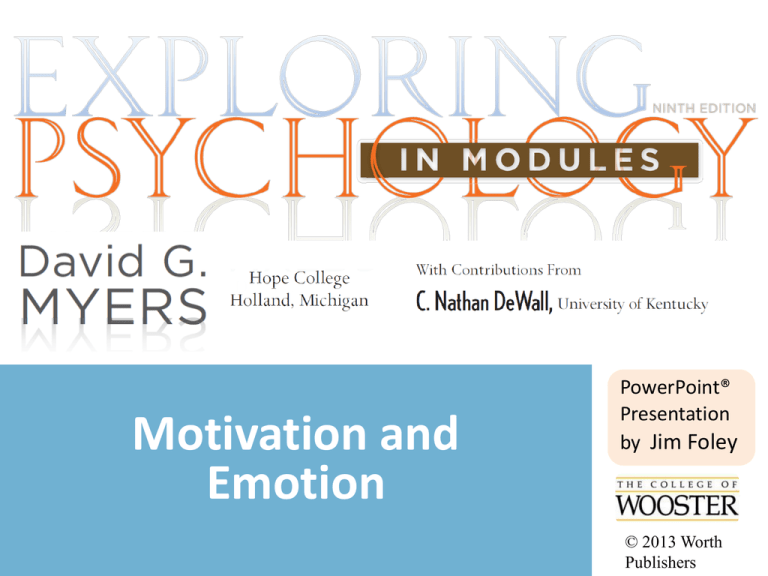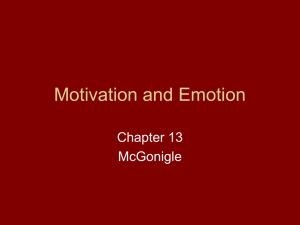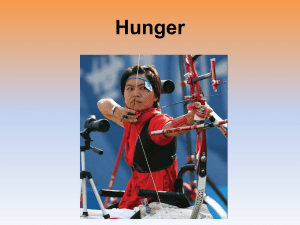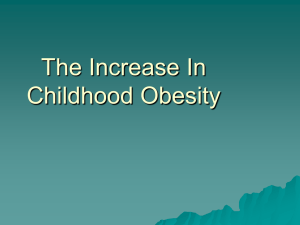Hunger - CCRI Faculty Web
advertisement

Motivation and Emotion PowerPoint® Presentation by Jim Foley © 2013 Worth Publishers Module 29: Hunger Topics you might be hungry to learn about Hunger: Body Chemistry and Brain control of Hunger Cultural and Situational effects on Hunger Obesity and weight control challenges: Physiology, social factors, food and activity factors A closer look at one need/motive: Hunger Research on hunger is consistent with Abraham Maslow’s hierarchy: In one study, men whose food intake had been cut in half became obsessed with food. Hunger even changes our motivations as we plan for the future. Physiology of Hunger Experiments and other investigations show a complex relationship among the stomach, hormones, and different parts of the brain. Feeling hungry can include stomach contractions; the feeling can happen even if the stomach is removed or filled with a balloon. The Hypothalamus and Hunger Receptors in the digestive system monitor levels of glucose and send signals to the hypothalamus in the brain. The hypothalamus then can send out appetitestimulating hormones to tell the body: time to eat! The Body Talks Back to the Brain The hypothalamus sends appetite-stimulating hormones, and later, after eating, sends appetitesuppressing hormones. Hormones travel from various organs of the body back to the brain to convey messages that increase or decrease appetite. Regulating Weight When a person’s weight drops or increases, the body responds by adjusting hunger and energy use to bring weight back to its initial stable amount. Most mammals, without consciously regulating, have a stable weight to which they keep returning. This is also known as their set point. A person’s set point might rise with age, or change with economic or cultural conditions. Therefore, this “set point” of stable weight is more of a current but temporary “settling point.” Which foods to eat? Taste Preferences Some taste preferences are universal. Carbohydrates temporarily raise levels of serotonin, reducing stress and depression. Other tastes are acquired and become favorites through exposure, culture, and conditioning. Different cultures encourage different tastes. Some cultures find these foods to be delicious: reindeer fat and berries, or roasted guinea pig. Biology, Evolution, and Taste Preferences Differences in taste preferences are not arbitrary. Personal and cultural experience, influenced by biology, play a role. We can acquire a food aversion after just one incident of getting sick after tasting a food. It is adaptive in warm climates to develop a taste for salt and spice, which preserve food. Disliking new tastes (neophobia) may have helped to protect our ancestors. How much do we eat? Eating depends in part on situational influences. Social facilitation: the presence of others accentuates our typical eating habits Unit bias: we may eat only one serving/unit (scoop, plateful, bun-full) of food, but will eat more if the serving size is larger Buffet effect: we eat more if more options are available Influences on Eating Behavior Do we need to control our hunger? When we eat enough to noticeably gain weight, we can face discrimination, bullying, and depression. Standards for body size can vary in different cultures, sometimes creating an unhealthy norm of being overweight or underweight. Body fat has been seen as a sign of affluence, and thus has been considered attractive. But at a certain ratio of weight to height, health risks arise. The Physiology of Obesity Having some body fat is normal and healthy; fat stores energy. Being mildly overweight is not necessarily a problem if the person is in good physical condition or exercising. Obesity can lead to health problems, including diabetes, heart disease, cognitive decline, and some cancers. The physiology of obesity can also make it hard to lose weight, due to set point/metabolism, genetics, appetite, and lifestyle factors. Obesity, and losing weight, is not just an issue of motivation. Set Point and Metabolism For a variety of reasons, a person’s set point, the stable weight the body keeps returning to, drifts from a healthy weight. Those who becomes overweight develop a new set point that is now hard to shift. Why? Once the set point has shifted, metabolism shifts to maintain it; resting metabolism slows. Starving to lose weight slows metabolism further. Hunger kicks in when weight goes below he new set point. Because the body works this way: It is thus easier to stay lean than become lean. The Genetics of Obesity Adopted siblings eating the same meals end up with a BMI/weight resembling biological parents, not people in the same household. Identical twins have similar weights, even when raised apart with different food. There seem to be many genes with effects on weight. Lifestyle Factors and Obesity People who are restless and fidgeting burn off more calories and gain less weight than others. Inadequate sleep causes weight gain, despite increased active time, because of appetite hormones. Having an obese friend correlates with becoming obese. Sedentary lifestyles and fast food may be leading to increased body fat worldwide. Prevalence of Obesity Rates of being overweight BMI (body mass index) >30: Obese Projected 1 billion people worldwide are overweight, 300 million of which are obese (BMI >30). Obesity and Weight Control How does obesity develop, and why is it hard to change? It was adaptive for our ancestors to crave energy-rich food when available. Problem: energy-rich ‘junk’ food is now easily available, and cheaper than healthy food It is adaptive to slow down our burning of fat when food is scarce. Problem: in poverty or in crash diets, our body can slow down weight loss Losing Weight: The Challenge Because of the physiological factors and perhaps due to lifestyle and peer issues: once obese, weight loss is difficult, and permanent weight loss is even harder. obsessive weight loss attempts can add to shame, anxiety, depression, and disordered eating habits. Losing Weight: The Plan If you decide to move your body’s set point to a lower body weight: Begin with an understanding of the metabolic challenges you face, so that you blame slow progress on physiology, not poor willpower. Begin with self-acceptance and a decision to change, rather than feeling shame. Make gradual and consistent, not drastic and varying, lifestyle changes. Increase exercise and healthy food choices. Get support.











